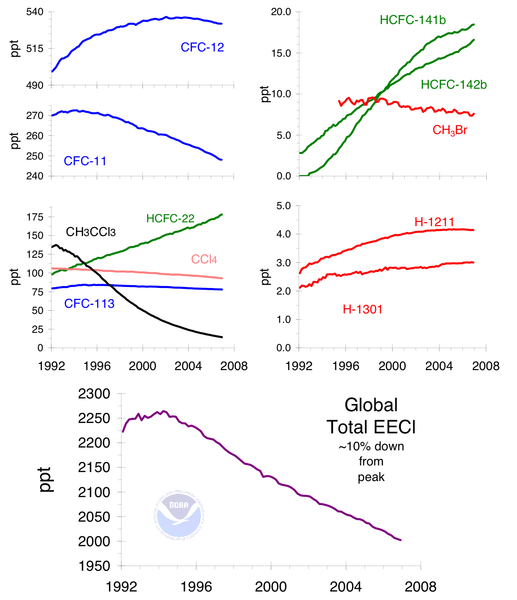Archivo:Ozone cfc trends.png
Apariencia

Tamaño de esta previsualización: 517 × 600 píxeles. Otras resoluciones: 207 × 240 píxeles · 414 × 480 píxeles · 662 × 768 píxeles · 1096 × 1271 píxeles.
Ver la imagen en su resolución original (1096 × 1271 píxeles; tamaño de archivo: 123 kB; tipo MIME: image/png)
Historial del archivo
Haz clic sobre una fecha y hora para ver el archivo tal como apareció en ese momento.
| Fecha y hora | Miniatura | Dimensiones | Usuario | Comentario | |
|---|---|---|---|---|---|
| actual | 22:00 2 oct 2016 |  | 1096 × 1271 (123 kB) | Cmdrjameson | Compressed with pngout. Reduced by 46kB (27% decrease). |
| 04:11 6 oct 2009 |  | 1096 × 1271 (169 kB) | Robert Skyhawk | Updated information current to 2008. Upload requested by English Wikipedia user Tobus2 via Images for Upload. | |
| 19:38 15 ene 2006 |  | 1139 × 1577 (24 kB) | Maksim | La bildo estas kopiita de wikipedia:en. La originala priskribo estas: CFC gas trends and equivalent chlorine effect. Combined chlorine and bromine in the lower stratosphere (10-25 km), where most ozone loss occurs, leveled off around [ |
Usos del archivo
Las siguientes páginas usan este archivo:
Uso global del archivo
Las wikis siguientes utilizan este archivo:
- Uso en bg.wikipedia.org
- Uso en ca.wikipedia.org
- Uso en el.wikipedia.org
- Uso en en.wikipedia.org
- Uso en eo.wikipedia.org
- Uso en eu.wikipedia.org
- Uso en fi.wikipedia.org
- Uso en fr.wikipedia.org
- Uso en gu.wikipedia.org
- Uso en hi.wikipedia.org
- Uso en id.wikipedia.org
- Uso en kn.wikipedia.org
- Uso en pt.wikipedia.org
- Uso en simple.wikipedia.org
- Uso en ta.wikipedia.org
- Uso en zh.wikipedia.org



